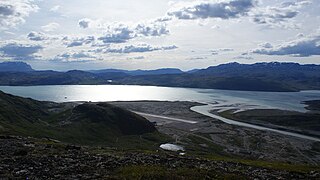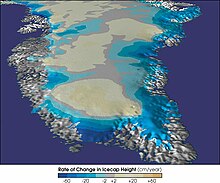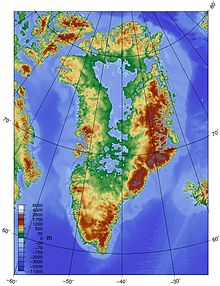
Greenland is a North American island autonomous territory of the Kingdom of Denmark. It is the larger of two autonomous territories within the Kingdom, the other being the Faroe Islands; the citizens of both territories are full citizens of Denmark. As Greenland is one of the Overseas Countries and Territories of the European Union, citizens of Greenland are European Union citizens. The capital and largest city of Greenland is Nuuk. Greenland lies between the Arctic and Atlantic oceans, east of the Canadian Arctic Archipelago. It is the world's largest island, and is the location of the northernmost point of land in the world – Kaffeklubben Island off the northern coast is the world's northernmost undisputed point of land, and Cape Morris Jesup on the mainland was thought to be so until the 1960s.

Greenland is located between the Arctic Ocean and the North Atlantic Ocean, northeast of Canada and northwest of Iceland. The territory comprises the island of Greenland—the largest island in the world—and more than a hundred other smaller islands. Greenland has a 1.2-kilometer-long (0.75 mi) border with Canada on Hans Island. A sparse population is confined to small settlements along certain sectors of the coast. Greenland possesses the world's second-largest ice sheet.

Nuuk is the capital of and most populous city in Greenland, an autonomous territory in the Kingdom of Denmark. Nuuk is the seat of government and the territory's largest cultural and economic center. Nuuk is also the seat of government for the Sermersooq municipality. In January 2024, it had a population of 19,872, - more than a third of the country’s population - making it one of the smallest capital cities in the world by population. Nuuk is considered a modernized city after the policy began in 1950.

Upernavik is a small town in the Avannaata municipality in northwestern Greenland, located on a small island of the same name. With 1,064 inhabitants as of 2024, it is the twelfth-largest town in Greenland. It contains the Upernavik Museum.

Kangerlussuaq is a settlement in western Greenland in the Qeqqata municipality located at the head of the fjord of the same name. It was Greenland's main air transport hub and the site of Greenland's largest commercial airport until the new airport opened at Nuuk on 28th November 2024. The airport dates from American settlement during and after World War II, when the site was known as Bluie West-8 and then Sondrestrom Air Base.

Ilulissat, formerly Jakobshavn or Jacobshaven, is the municipal seat and largest town of the Avannaata municipality in western Greenland, located approximately 350 km (220 mi) north of the Arctic Circle. With a population of 4,670 as of 2020, it is the third-largest city in Greenland, after Nuuk and Sisimiut. The city is home to almost as many sled-dogs as people.

Narsarsuaq is a settlement in the Kujalleq municipality in southern Greenland. It had 123 inhabitants in 2020. There is a thriving tourism industry in and around Narsarsuaq, whose attractions include a great diversity of wildlife, gemstones, tours to glaciers, and an airfield museum.

Aasiaat or Ausiait, formerly Egedesminde, is a town in the Qeqertalik municipality in western Greenland, located on its namesake island in the heart of Aasiaat Archipelago at the southern end of Disko Bay. With a population of 2,980 as of 2021, it is Greenland's fifth-largest town.

Kangerlussuaq Airport is an airport in Kangerlussuaq, a settlement in the Qeqqata municipality in central-western Greenland. Alongside Nuuk Airport and Narsarsuaq Airport, it is one of only three civilian airports in Greenland large enough to handle large aircraft.

Tasiilaq, formerly Ammassalik or Angmagssalik and King Oscar Haven, is a town on Ammassalik Island in southeastern Greenland, within the municipality of Sermersooq. With 1,985 inhabitants as of 2020, it is the most populous community on the eastern coast, and the seventh-largest town in Greenland. The Sermilik Station, dedicated to the research of the nearby Mittivakkat Glacier, is located near the town.

Paamiut, formerly Frederikshåb, is a town in southwestern Greenland in the Sermersooq municipality.

Ittoqqortoormiit, formerly known as Scoresbysund, is a settlement in the Sermersooq municipality in eastern Greenland. Its population was 345 as of 2020, and it has been described as one of the most remote settlements on Earth.

The Danish Meteorological Institute is the official Danish meteorological institute, administrated by the Ministry of Climate, Energy and Utilities. It makes weather forecasts and observations for Denmark, Greenland, and the Faroe Islands.

Jakobshavn Glacier, also known as Ilulissat Glacier, is a large outlet glacier in West Greenland. It is located near the Greenlandic town of Ilulissat and ends at the sea in the Ilulissat Icefjord.

Danmarkshavn is a small weather station located in Dove Bay, on the northeastern shore of the Germania Land Peninsula, in Northeast Greenland National Park, Greenland.
Tourism in Greenland is a relatively young business area of the country. Since the foundation of the national tourist council, Greenland Tourism, in 1992, the Home Rule Government has been working actively with promoting the destination and helping smaller tourist providers to establish their services. Foreign travel agencies have increasingly been opening up sale of Greenland trips and tours, and the cruise industry has had a relatively large increase in routes to Greenland since about the turn of the century.

The tundra climate is a polar climate sub-type located in high latitudes and high mountains. It is classified as ET according to the Köppen climate classification. It is a climate which at least one month has an average temperature high enough to melt snow, but no month with an average temperature in excess of 10 °C (50 °F). If the climate occurs at high elevations, it is known as alpine climate.

Summit Camp, also known as Summit Station, is a year-round staffed research station near the apex of the Greenland ice sheet. The station is located at 3,216 metres (10,551 ft) above sea level.

The climate of the Nordic countries is that of a region in Northern Europe that consists of Denmark, Finland, Iceland, Norway and Sweden and their associated territories, which include the Faroe Islands, Greenland and Åland. Stockholm, Sweden has on average the warmest summer of the Nordic capitals, with an average maximum temperature of 23 °C (73 °F) in July; Copenhagen, Oslo and Helsinki have an average July maximum temperature of 22 °C (72 °F).
Panzgam is a village in Awantipora tehsil of Pulwama district, Jammu and Kashmir, India. It is 19 kilometres (12 mi) from Pulwama district headquarters and 45 kilometres (28 mi) from Srinagar. It is located at the boundary of Awantipora Tehsil.





















